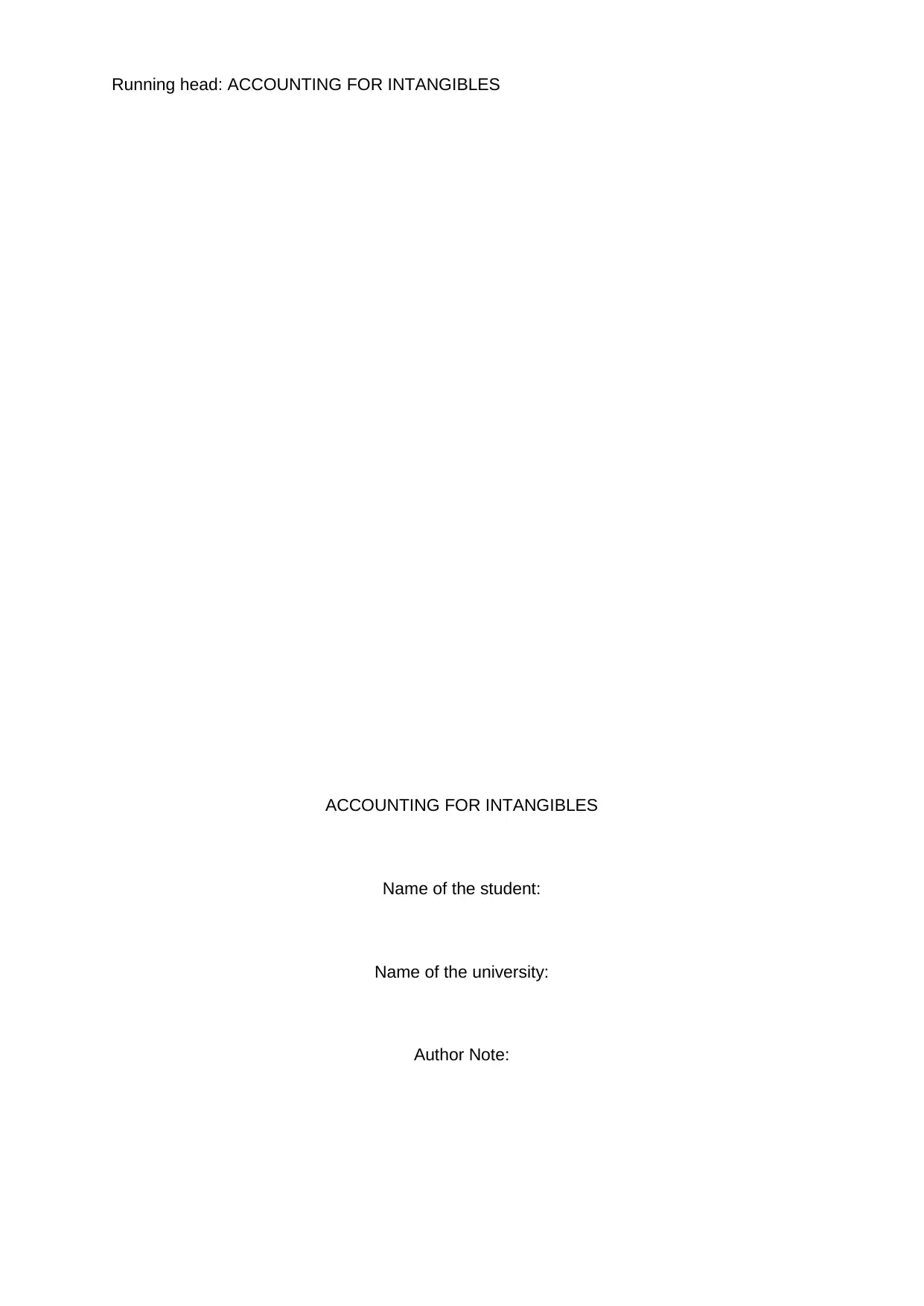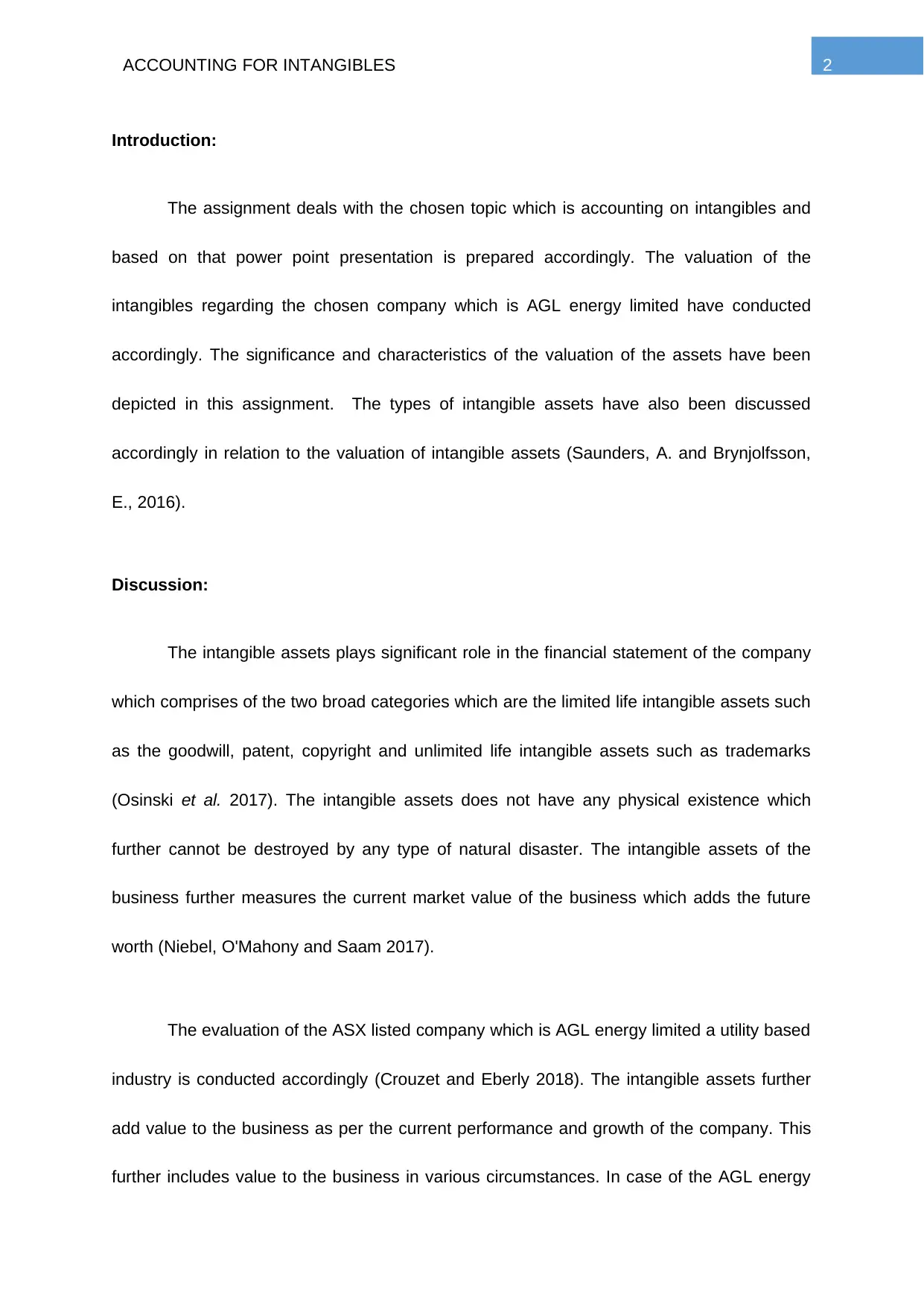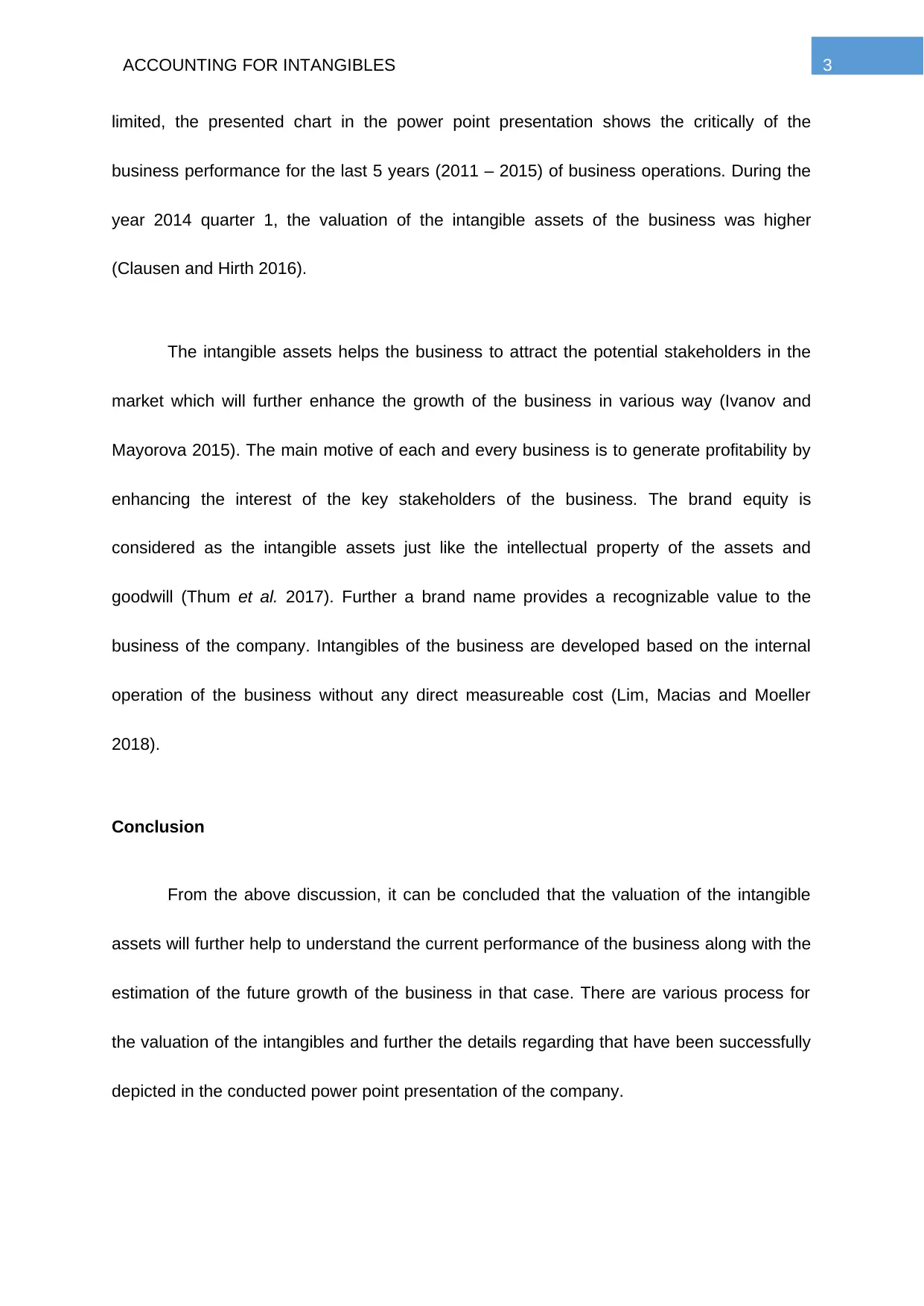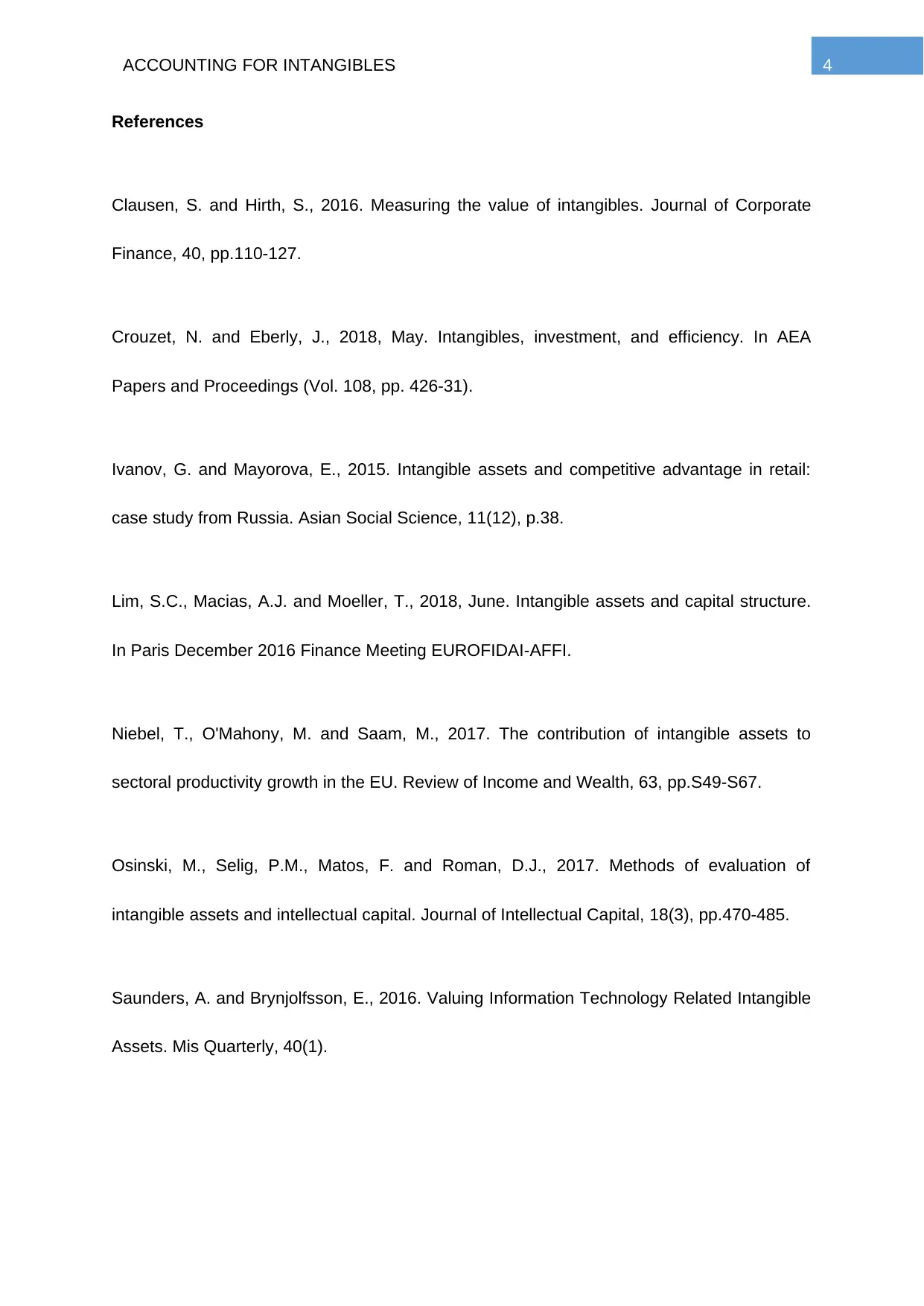Issues in Financial Accounting: Intangibles of AGL Energy Limited
VerifiedAdded on 2022/11/13
|6
|828
|451
Presentation
AI Summary
This presentation delves into the accounting for intangible assets, focusing on a valuation analysis of AGL Energy Limited, an ASX-listed utility company. The assignment explores the significance of intangible assets in financial statements, differentiating between limited-life and unlimited-life assets like goodwill, patents, trademarks, and copyrights. It examines the role of intangibles in measuring business market value and attracting stakeholders, with specific reference to AGL Energy's performance from 2011 to 2015. The presentation highlights the importance of brand equity and intellectual property as intangible assets and discusses how these assets are developed through internal operations. The conclusion emphasizes the importance of intangible asset valuation in understanding current business performance and projecting future growth, as well as the methods used in their valuation.

Running head: ACCOUNTING FOR INTANGIBLES
ACCOUNTING FOR INTANGIBLES
Name of the student:
Name of the university:
Author Note:
ACCOUNTING FOR INTANGIBLES
Name of the student:
Name of the university:
Author Note:
Paraphrase This Document
Need a fresh take? Get an instant paraphrase of this document with our AI Paraphraser

1ACCOUNTING FOR INTANGIBLES
Table of Contents
Introduction:........................................................................................................................... 2
Discussion:............................................................................................................................. 2
Conclusion............................................................................................................................. 3
Table of Contents
Introduction:........................................................................................................................... 2
Discussion:............................................................................................................................. 2
Conclusion............................................................................................................................. 3

2ACCOUNTING FOR INTANGIBLES
Introduction:
The assignment deals with the chosen topic which is accounting on intangibles and
based on that power point presentation is prepared accordingly. The valuation of the
intangibles regarding the chosen company which is AGL energy limited have conducted
accordingly. The significance and characteristics of the valuation of the assets have been
depicted in this assignment. The types of intangible assets have also been discussed
accordingly in relation to the valuation of intangible assets (Saunders, A. and Brynjolfsson,
E., 2016).
Discussion:
The intangible assets plays significant role in the financial statement of the company
which comprises of the two broad categories which are the limited life intangible assets such
as the goodwill, patent, copyright and unlimited life intangible assets such as trademarks
(Osinski et al. 2017). The intangible assets does not have any physical existence which
further cannot be destroyed by any type of natural disaster. The intangible assets of the
business further measures the current market value of the business which adds the future
worth (Niebel, O'Mahony and Saam 2017).
The evaluation of the ASX listed company which is AGL energy limited a utility based
industry is conducted accordingly (Crouzet and Eberly 2018). The intangible assets further
add value to the business as per the current performance and growth of the company. This
further includes value to the business in various circumstances. In case of the AGL energy
Introduction:
The assignment deals with the chosen topic which is accounting on intangibles and
based on that power point presentation is prepared accordingly. The valuation of the
intangibles regarding the chosen company which is AGL energy limited have conducted
accordingly. The significance and characteristics of the valuation of the assets have been
depicted in this assignment. The types of intangible assets have also been discussed
accordingly in relation to the valuation of intangible assets (Saunders, A. and Brynjolfsson,
E., 2016).
Discussion:
The intangible assets plays significant role in the financial statement of the company
which comprises of the two broad categories which are the limited life intangible assets such
as the goodwill, patent, copyright and unlimited life intangible assets such as trademarks
(Osinski et al. 2017). The intangible assets does not have any physical existence which
further cannot be destroyed by any type of natural disaster. The intangible assets of the
business further measures the current market value of the business which adds the future
worth (Niebel, O'Mahony and Saam 2017).
The evaluation of the ASX listed company which is AGL energy limited a utility based
industry is conducted accordingly (Crouzet and Eberly 2018). The intangible assets further
add value to the business as per the current performance and growth of the company. This
further includes value to the business in various circumstances. In case of the AGL energy
⊘ This is a preview!⊘
Do you want full access?
Subscribe today to unlock all pages.

Trusted by 1+ million students worldwide

3ACCOUNTING FOR INTANGIBLES
limited, the presented chart in the power point presentation shows the critically of the
business performance for the last 5 years (2011 – 2015) of business operations. During the
year 2014 quarter 1, the valuation of the intangible assets of the business was higher
(Clausen and Hirth 2016).
The intangible assets helps the business to attract the potential stakeholders in the
market which will further enhance the growth of the business in various way (Ivanov and
Mayorova 2015). The main motive of each and every business is to generate profitability by
enhancing the interest of the key stakeholders of the business. The brand equity is
considered as the intangible assets just like the intellectual property of the assets and
goodwill (Thum et al. 2017). Further a brand name provides a recognizable value to the
business of the company. Intangibles of the business are developed based on the internal
operation of the business without any direct measureable cost (Lim, Macias and Moeller
2018).
Conclusion
From the above discussion, it can be concluded that the valuation of the intangible
assets will further help to understand the current performance of the business along with the
estimation of the future growth of the business in that case. There are various process for
the valuation of the intangibles and further the details regarding that have been successfully
depicted in the conducted power point presentation of the company.
limited, the presented chart in the power point presentation shows the critically of the
business performance for the last 5 years (2011 – 2015) of business operations. During the
year 2014 quarter 1, the valuation of the intangible assets of the business was higher
(Clausen and Hirth 2016).
The intangible assets helps the business to attract the potential stakeholders in the
market which will further enhance the growth of the business in various way (Ivanov and
Mayorova 2015). The main motive of each and every business is to generate profitability by
enhancing the interest of the key stakeholders of the business. The brand equity is
considered as the intangible assets just like the intellectual property of the assets and
goodwill (Thum et al. 2017). Further a brand name provides a recognizable value to the
business of the company. Intangibles of the business are developed based on the internal
operation of the business without any direct measureable cost (Lim, Macias and Moeller
2018).
Conclusion
From the above discussion, it can be concluded that the valuation of the intangible
assets will further help to understand the current performance of the business along with the
estimation of the future growth of the business in that case. There are various process for
the valuation of the intangibles and further the details regarding that have been successfully
depicted in the conducted power point presentation of the company.
Paraphrase This Document
Need a fresh take? Get an instant paraphrase of this document with our AI Paraphraser

4ACCOUNTING FOR INTANGIBLES
References
Clausen, S. and Hirth, S., 2016. Measuring the value of intangibles. Journal of Corporate
Finance, 40, pp.110-127.
Crouzet, N. and Eberly, J., 2018, May. Intangibles, investment, and efficiency. In AEA
Papers and Proceedings (Vol. 108, pp. 426-31).
Ivanov, G. and Mayorova, E., 2015. Intangible assets and competitive advantage in retail:
case study from Russia. Asian Social Science, 11(12), p.38.
Lim, S.C., Macias, A.J. and Moeller, T., 2018, June. Intangible assets and capital structure.
In Paris December 2016 Finance Meeting EUROFIDAI-AFFI.
Niebel, T., O'Mahony, M. and Saam, M., 2017. The contribution of intangible assets to
sectoral productivity growth in the EU. Review of Income and Wealth, 63, pp.S49-S67.
Osinski, M., Selig, P.M., Matos, F. and Roman, D.J., 2017. Methods of evaluation of
intangible assets and intellectual capital. Journal of Intellectual Capital, 18(3), pp.470-485.
Saunders, A. and Brynjolfsson, E., 2016. Valuing Information Technology Related Intangible
Assets. Mis Quarterly, 40(1).
References
Clausen, S. and Hirth, S., 2016. Measuring the value of intangibles. Journal of Corporate
Finance, 40, pp.110-127.
Crouzet, N. and Eberly, J., 2018, May. Intangibles, investment, and efficiency. In AEA
Papers and Proceedings (Vol. 108, pp. 426-31).
Ivanov, G. and Mayorova, E., 2015. Intangible assets and competitive advantage in retail:
case study from Russia. Asian Social Science, 11(12), p.38.
Lim, S.C., Macias, A.J. and Moeller, T., 2018, June. Intangible assets and capital structure.
In Paris December 2016 Finance Meeting EUROFIDAI-AFFI.
Niebel, T., O'Mahony, M. and Saam, M., 2017. The contribution of intangible assets to
sectoral productivity growth in the EU. Review of Income and Wealth, 63, pp.S49-S67.
Osinski, M., Selig, P.M., Matos, F. and Roman, D.J., 2017. Methods of evaluation of
intangible assets and intellectual capital. Journal of Intellectual Capital, 18(3), pp.470-485.
Saunders, A. and Brynjolfsson, E., 2016. Valuing Information Technology Related Intangible
Assets. Mis Quarterly, 40(1).

5ACCOUNTING FOR INTANGIBLES
Thum, A.E., Voigt, P., Bilbao-Osorio, B., Maier, C. and Ognyanova, D., 2017. Unlocking
Investment in Intangible Assets (No. 047). Directorate General Economic and Financial
Affairs (DG ECFIN), European Commission.
Thum, A.E., Voigt, P., Bilbao-Osorio, B., Maier, C. and Ognyanova, D., 2017. Unlocking
Investment in Intangible Assets (No. 047). Directorate General Economic and Financial
Affairs (DG ECFIN), European Commission.
⊘ This is a preview!⊘
Do you want full access?
Subscribe today to unlock all pages.

Trusted by 1+ million students worldwide
1 out of 6
Related Documents
Your All-in-One AI-Powered Toolkit for Academic Success.
+13062052269
info@desklib.com
Available 24*7 on WhatsApp / Email
![[object Object]](/_next/static/media/star-bottom.7253800d.svg)
Unlock your academic potential
Copyright © 2020–2025 A2Z Services. All Rights Reserved. Developed and managed by ZUCOL.





